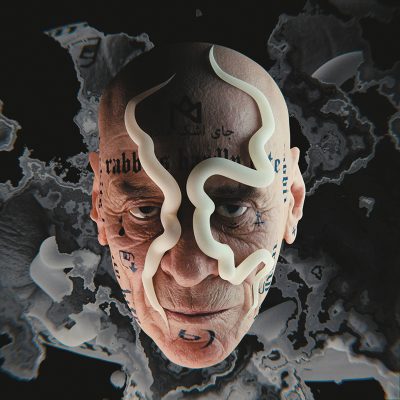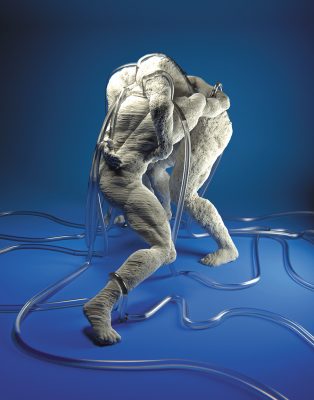Hirad Sab: Art for an Anarchic Future
Art
Scrolling through local artist Hirad Sab’s website (hiradsab.com) is like watching a strange, distorted projection of the not-so-far-off future unfold in front of you. Sleek chrome bodies fall away into glitching, semi-recognizable landscapes while the line between organic matter and digital projections blurs beyond distinction. There’s some acknowledgement of his predecessors—particularly the similarities to ancient marble sculptures—but the overall projections look past current knowledge, forming unique, haunting scenes. Sab’s attitude toward his work follows a similar mindset: conscious of the past but constantly looking ahead toward new means of expression and creation.
 Sab has garnered the most attention for his music video work for artists like Ash Koosha, Sevdaliza and Lapalux. Sab’s music videos share similar features with Sab’s solo work, though with slight twists to accommodate the music —on which Sab places extreme focus and detail. The recognizable but nonetheless alien human forms interact with objects that can only exist in a technology-saturated universe. In his video for Lapalux’s “Petty Passion,” a shimmering octopus wraps around a body encased in ropes, both in sensual and aggressive fashions. Outside of Sab’s precision in matching digital effects with audio frequencies, his visuals perfectly match the music’s meshing of slick, electronic textures and vocal samples with grinding synthesizers and flattening sub-bass.
Sab has garnered the most attention for his music video work for artists like Ash Koosha, Sevdaliza and Lapalux. Sab’s music videos share similar features with Sab’s solo work, though with slight twists to accommodate the music —on which Sab places extreme focus and detail. The recognizable but nonetheless alien human forms interact with objects that can only exist in a technology-saturated universe. In his video for Lapalux’s “Petty Passion,” a shimmering octopus wraps around a body encased in ropes, both in sensual and aggressive fashions. Outside of Sab’s precision in matching digital effects with audio frequencies, his visuals perfectly match the music’s meshing of slick, electronic textures and vocal samples with grinding synthesizers and flattening sub-bass.
Fundamentally—as it concerns his individual projects—creative freedom and a lack of anticipated narrative or concept are some of the most important qualities for Sab’s work. Instead of using digital programs with built-in tools, Sab prefers an open-source format. The user is free to alter or add any feature they please. He says, “If you start exposing the fundamental blocks that create something like Photoshop and you give these tools to people in an open-source format, I think it opens a lot more opportunities for people to start exploring what they want to.” More than creating a user-friendly environment that can easily replicate conventions, Sab wants to use the mutability of code to showcase and explore the limitless possibilities inherent in digital art.
Given this love for widely available tools for expression (and in contrast to his distaste for “commercial art”), Sab is an artist who actively complicates the idea of authorship and authenticity in art. “I’m very open to collaboration,” he says, “be it a conscious, direct collaboration or be it an unconscious remix of mine or someone else’s work. If there’s any code or there’s any program that I’ve been working on, almost 100 percent of that is available to the public if they’re interested in it.”
Even though his music videos showcase bounds of creativity and technical skill, Sab is wary of the limitations of music videos and the nature of linear video work as an expressive medium, as each video stops changing once it goes live online. “You’re dealing with a 2D non-space,” he says. “There’s no physicality to it, and there’s no way to feel it with your body or to interact with it.” Sab wishes to bridge the disconnect between the work and the viewer. He describes his ideal music-art combination as “not a music video but an interactive audio-visual experience where the frames can alter at any point in time.” Participants would use virtual-reality technology to control the visuals and react to the sound around them. Rather than providing a visual counterpart to music, Sab wants to fully immerse his audience in the art, as witnesses and active creators.
Moving forward, Sab seeks to satisfy his artistic appetite by focusing on his solo work. “I’ve established some sort of style or aesthetic of mine, so a lot of people come to me and want that. It’s this recursive loop now, and I feel like I keep creating the same thing with slight differences,” he says. While he expresses his gratitude for the experiences and the exposure that these projects gave him, Sab feels that—for the time being—it’s time to move past the commissioned work and focus solely on his individual projects.
slight differences,” he says. While he expresses his gratitude for the experiences and the exposure that these projects gave him, Sab feels that—for the time being—it’s time to move past the commissioned work and focus solely on his individual projects.
Ultimately, Sab views digital art as one method of expression, one he hopes eventually to mix with other media in order to fully explore the ways technology and the arts can meet. While describing a litany of unfinished and unreleased projects, Sab outlines future ideas: creating video art out of deconstructed audio frequencies, drawing installations based around drones and creating pieces that combine digital and physical objects. One project he seems particularly excited about involves artificial neural networks and their artistic potential. Essentially, with the right coding, neural networks can learn how to replicate and create anything, going as far as rendering real-life images in the style of famous artists. “Now imagine doing that with videos,” he says, grinning gleefully.
Another extension of Sab’s techno-art is his desire to create web-based tools for artists around the world. He even notes that, currently, he finds himself much more interested in this project than any traditional artistic endeavor. His program of choice, the entirely open-source Blender, allows him to build new add-ons with ease. His current focus is a plug-in that designs and prints a 3D model based around real objects—using the example of printing coral that perfectly fits around the rim of a mug, as one of many possibilities. “I don’t think that my form of expression needs to be a canvas,” says Sab. “Sometimes it can be the brush.”